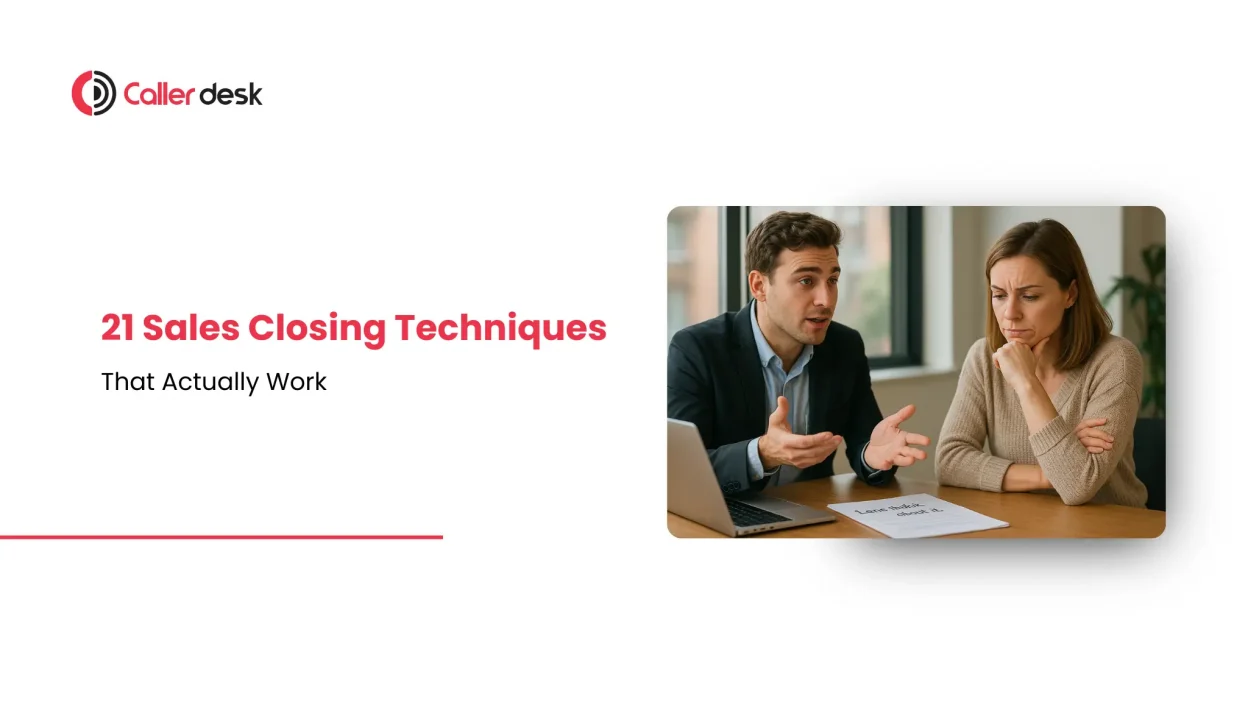You talk to a customer.
You tell them everything about your product.
They seem interested.
But when you ask, “Are you ready to buy?”-they say,
“Let me think about it.”
This happens to a lot of salespeople.
In fact, more than 1 in 3 salespeople say that closing a sale is the hardest part of their job. And it’s true. People today want to do research, compare prices, and take their time before saying yes.
That’s why knowing how to close a sale the right way is so important.
You can’t just push someone to buy.
You need to help them feel confident, clear, and ready.
This is where sales closing techniques come in. These are simple ways to guide a customer step-by-step—so they feel good about saying “yes.”
In this blog, I’ll show you 21 easy techniques that smart salespeople use every day.
You’ll learn what each one means, when to use it, and how it helps you close more deals.
Let’s get started!
What Is a Sales Closing Technique?
A sales closing technique is a way to help someone decide to buy from you.
Let’s say a person is interested in your product, but they’re still thinking about it. A closing technique helps them stop thinking and start saying “Yes, I’ll take it.”
It’s like giving them a little push at the right time—without pressure.
Some techniques make them feel more sure.
Some show why it’s a good idea to buy now.
Others just make everything easier to understand.
In the end, a closing technique helps the buyer feel ready and confident to say yes.
It’s not about forcing them.
It’s about helping them make the right choice—faster and easier.
21 Sales Closing Techniques You Can Use to Win More Deals
Closing a deal is the final and most important step in sales. It’s the moment when a potential customer says “yes” and becomes a paying customer. But getting to that “yes” isn’t always easy.
Sometimes the buyer is unsure. Sometimes they need more information. And other times, they just need a little nudge.
That’s where sales closing techniques come in. These are smart methods you can use to guide your prospect toward making a confident decision—without being pushy.
Here are 21 easy-to-understand and effective sales closing techniques that actually work.
1. Assumptive Close
This technique works by talking as if the customer has already made the decision. Instead of asking if they want to buy, you ask when they want to start. For example, “Should we begin on Monday or Tuesday?” It helps move the conversation forward and makes it easier for them to agree.
2. Now-or-Never Close
Here, you offer something for a limited time to create urgency. It could be a discount, a bonus, or early access. The idea is to push them to act quickly without feeling rushed. A good example: “This offer is only available until Friday.”
3. Options Close
Instead of asking a yes or no question, give the customer two options. This helps them feel in control and makes it easier to choose. You could say, “Would you prefer the 3-month or the 6-month plan?”
4. Question Close
This technique uses simple, open-ended questions to guide the customer. You ask things like, “Does this sound like the solution you were looking for?” It helps them express what they need—and gives you a chance to match your product to it.
5. Summary Close
When the conversation is about to end, summarize everything they liked. This reminds them why your product is a good fit. For example: “You said you wanted something fast, affordable, and reliable. Our plan checks all those boxes.”
6. Trial Close
Use this when you want to check their interest without directly asking for the sale. You could ask, “Would it help if I showed you a customer story?” It’s a safe way to keep the conversation going.
7. Sharp Angle Close
If the buyer asks for a discount or extra feature, use that as a chance to close. Say something like, “If I can give you free setup, can we get this started today?” It makes both sides feel like they’re getting value.
8. Columbo Close
Inspired by an old TV detective, this technique is about asking one last question before you leave. It sounds casual but can bring out final objections. Like: “Before I go—what’s holding you back from saying yes today?”
9. Take-Away Close
If the customer says the price is too high, offer to remove a feature to meet their budget. For example: “We can bring the price down by removing the advanced dashboard. Would that work?”
10. Visual Close
Show, don’t just tell. Use videos, images, or charts to explain how your product works. Many people understand better when they can see something with their own eyes.
11. Just Because Close
Sometimes offering something small for free builds trust. Say something like, “We’ll add onboarding support at no extra cost-just to help you get started easier.” It feels generous, not salesy.
12. Objection Close
Don’t be afraid to ask directly if they have any doubts. It’s better to hear and handle them. Ask, “Is there anything stopping you from moving forward today?”
13. Value Close
When price becomes an issue, shift focus to value. Remind them of what they’re getting. “This tool will save you 10 hours a week. That’s time you can spend on more important work.”
14. FOMO Close
Use the Fear of Missing Out to your advantage. Let them know that others are already getting value. “Several companies in your industry are already using this to increase their sales.”
15. Empathy Close
Sometimes, showing understanding can build trust. Say, “I know change can be hard. We’ll support you every step of the way.” This helps the customer feel safe about their decision.
16. Story Close
Stories are powerful. Share real examples of how others succeeded using your product. “One of our clients had the same issue. After switching, they saved 30% in just 2 months.”
17. Scale Close
Ask the buyer to rate how ready they feel on a scale of 1 to 10. “Where would you place yourself right now?” This helps you know how close they are-and what’s holding them back.
18. Balance Sheet Close
List the pros and cons together. Help them see what they gain and what the risks are. Most times, the pros outweigh the cons, and it becomes easier to say yes.
19. Time-Need Close
Tie the decision to their schedule or deadline. “To meet your launch date, we’d need to get started by Friday.” This shows that taking action now is important.
20. Referral Close
Even if they’re not ready to buy, they might know someone who is. Ask, “Do you know anyone else who could benefit from this?” It’s a smart way to grow your network.
21. Hard Close
This is the most direct method. You ask clearly and respectfully: “Can we finalize this today and get started?” Use it when you’re confident the customer is ready but just waiting.
Tips to Help You Close More Sales
1. Understand Your Customer Before Selling
Before talking about your product, take time to listen. Ask questions and learn about what the customer really needs. When you understand their problems, you can show how your solution actually helps.
2. Don’t Rush the Sale
No one likes to be forced into a decision. Give your customer enough time to think. Guide them gently, but let them feel in control. A calm and relaxed customer is more likely to say yes.
3. Be Honest About Objections
If the customer has doubts or questions, answer them truthfully. And if you don’t know the answer, it’s okay to say, “Let me find out and get back to you.” Being honest builds trust-and trust leads to sales.
4. Always Follow Up
Many people won’t buy on the first call. That’s normal. Don’t give up. Send a message, make another call, or check in after a few days. A simple follow-up can be the difference between a lost deal and a closed one.
5. Stay Positive and Polite
Not every customer will say yes right away. And that’s okay. Even if someone says no today, they may come back later. Be respectful, stay friendly, and keep the door open for future opportunities.
Conclusion
Closing a sale is not about pushing people-it’s about helping them feel confident.
If someone says, “Let me think about it,” it usually means they’re unsure, not uninterested. That’s where your closing technique matters. The right words at the right time can guide them gently toward a decision.
In this blog, you’ve learned 21 sales closing techniques that actually work-whether it’s offering two options, creating urgency, asking smart questions, or just showing empathy.
But remember this: there’s no one-size-fits-all. Try a few, learn what works for your style, and most importantly-focus on helping, not just selling.
The more you understand your customer and use these techniques the right way, the more “yes” answers you’ll start hearing.
Keep practicing. Stay honest. Follow up. And don’t be afraid to ask for the sale-because confidence closes





